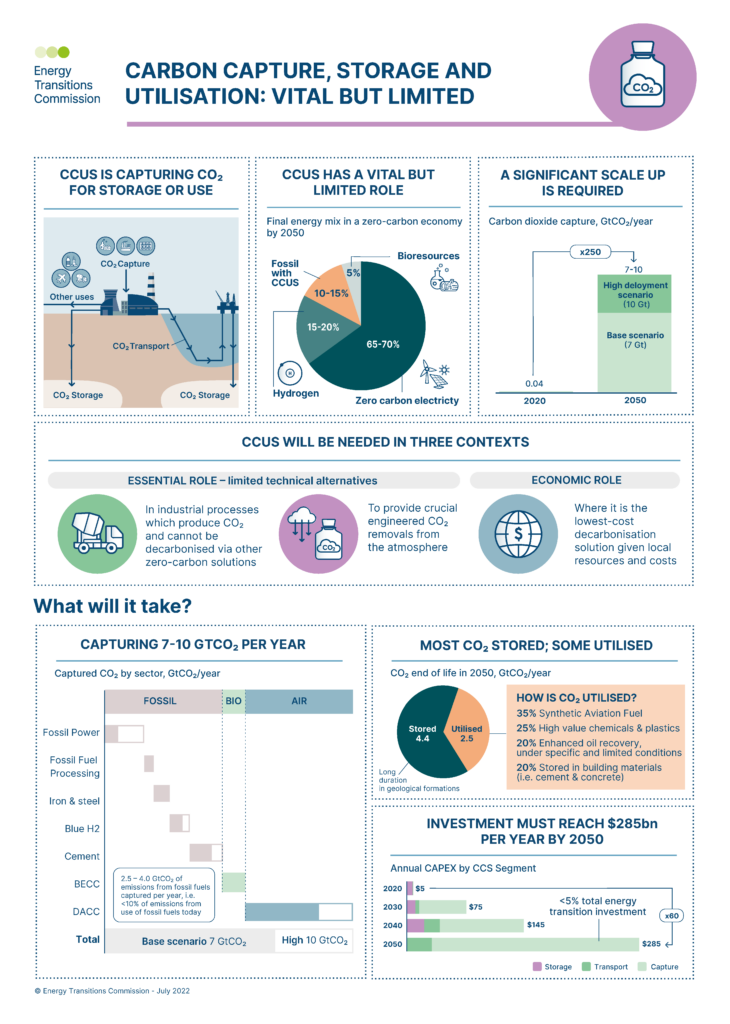The Energy Transitions Commission released a new report on carbon capture technologies, “Carbon Capture, Utilisation & Storage in the Energy Transition: Vital but Limited.” The study found that CCUS will play an important role in global decarbonization efforts, alongside other low-carbon and clean energy initiatives.
The report noted that CCUS is particularly useful in addressing carbon emissions from hard-to-abate industrial sectors and in specific regions and geographies where other decarbonization methods may not be economically viable. These are two issues that CAP has covered more in-depth before – to learn more check out our blog posts on the role of carbon capture and fossil fuels and the impact carbon capture can have on global energy security.
The ETC report argued that the primary means of reducing carbon emissions will be through clean electrification, the deployment of hydrogen, and sustainable, low-carbon bioresources. Notably, the study states:
“However, even with maximum possible energy efficiency improvement, and maximum possible, sustainable use of electricity, hydrogen and bioenergy there will be a necessary role for fossil fuels and a requirement therefore to apply CCUS if emissions are to reach net-zero. In addition, CCUS will be required to offset industrial process emissions (e.g. in cement plants) and to achieve permanent carbon removals.”
Noting that concerns over safety are one of the primary drivers of public opposition to CCUS, the report notes that, “CO2 can be transported safely and at low-cost via pipe, truck, or ship” and that CO2 pipelines are a “mature technology.” Likewise, “large-scale geological CO2 storage can be safe and permanent, provided it is well managed.”
Here in the U.S., carbon storage is highly regulated by the U.S. Environmental Protection Agency (EPA) under its authority to protect underground sources of drinking water. Carbon storage is managed by EPA’s Underground Injection Control (UIC) program and associated regulations, in addition to state-level oversight.
Finally, the report highlighted the important role of research and development, saying, “R&D and demonstration stage support targeting high efficiency operation, high capture rates and cost reductions across the CCUS value chain.”
In the U.S., the Department of Energy has been funding R&D for CCUS since at least 1997 within its Fossil Energy and Carbon Management Research, Development, Demonstration, and Deployment (FECM) portfolio. A Congressional Research Service report published in October 2021 found that since FY2010, Congress has provided $7.3 billion in appropriations for DOE carbon capture-related activities, including annual increases in recent years. Last year, 30% of FECM’s budget was dedicated to CCUS.
Earlier this month, DOE issued two Notices of Intent to fund programs that will advance carbon capture demonstration projects and expand regional pipeline works transporting CO2. Per DOE:
“The two programs – the Carbon Capture Demonstration Projects Program and the Carbon Dioxide Transport/Front-End Engineering Design (FEED) Program – are funded by a more than $2.6 billion investment from President Biden’s Bipartisan Infrastructure Law. Together, the programs build on the Administration’s recent actions to catalyze investments in clean energy and industrial innovation and advance President Biden’s goal of a net-zero greenhouse gas emissions economy by 2050—creating good paying jobs and economic opportunity.”
The CO2 pipeline program will design regional CO2 pipeline systems to transport CO2 from sources to centralized locations. Projects will, “expand DOE’s knowledge of carbon transport costs, transport network configurations, and technical and commercial considerations to support the country’s broader efforts to develop and deploy carbon capture and carbon dioxide removal technologies, carbon conversation, and storage at fully-commercial scale.
DOE further states that its research takes into consideration new CO2 pipeline safety measures announced by the Department of Transportation’s Pipeline and Hazardous Materials Safety Administration (PHMSA) this spring. CAP has covered CO2 pipeline safety before – you can read our blog post rebutting some of the more hyperbolic claims from a recent Pipeline Safety Trust report here. But it’s safe to say that, as we said then, our federal government is well-positioned to regulate the expansion of CO2 pipelines.
For more from the ETC report, check out this infographic they developed on the key findings.
